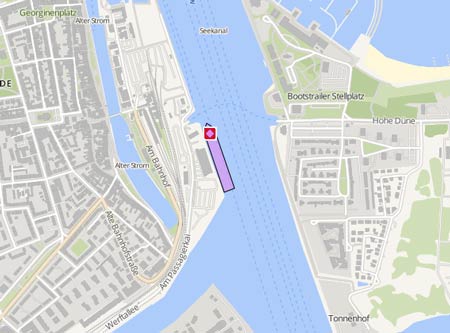DELTA LIFEBOAT
Kurs/Position
Die letzten Häfen
Die letzten Wegpunkte
Die neuesten Nachrichten
Lifeboat remains half sunk off Fraser River
On Dec 12 the Steveston marine artist John Horton went out in the morning to see what remained of the "Steveston" off the Fraser River. Horton was training some new people in the use of radar, when the ship got swept onto the rocks while making a turn around 7:30 p.m. on Dec 11. Although the "Steveston", formerly known as "Artist's Life", was only doing about four knots, the river was running hard when the ship ran onto the rock training wall on the south side of the south arm of the Fraser River. Horton, the ship's commander, was not at the wheel in that moment because he was getting ready to start the radar training. The helmsman was making a turn when the vessel was pushed sideways, and they were on the rocks in an instant. The lifeboat was lying partly sunk on its side between the pilings on the rocks with the forward end and bridge showing above water. The Canadian Lifeboat Institution's other vessel, the newly acquired "Fraser" had rescued five people before the Royal Canadian Marine Search and Rescue vessel "B.R. Hastings" arrived. Within 10 minutes, the rigid hull inflatable rescue vessel had been in the water and proceeded to remove the nine remaining people from the stricken boat. There were no serious injuries, though removing many of the people on board the "Steveston" was made challenging by the rough conditions and because some were older and had mobility issues. The "Steveston" was carrying up to 400 gallons of diesel at the time of the incident. What caused it to strike the wall remained unknown. It headed south west after exiting the harbour and directly toward the sandbar. Reports with photos: http://www.richmondreview.com/news/285642491.html http://www.cbc.ca/news/canada/british-columbia/steveston-rescue-14-people-pulled-from-sinking-boat-artist-life-1.2871080 http://www.richmond-news.com/news/photos-richmond-lifeboat-crashes-into-seawall-while-on-radar-training-mission-1.1663598 http://bc.ctvnews.ca/14-rescue-volunteers-rescued-after-wind-slams-boat-against-rocks-1.2145551
Richmond lifeboat crashes into seawall — while on radar training mission
John Horton, captain of the Steveston Lifeboat, was candid when explaining to the News why his vessel — with 14 passengers and crew on board — crashed straight into a seawall at the beginning of Thursday evening’s windstorm. Horton said moments before the collision on the south side of the south arm of the Fraser River around 7:30 p.m., he was showing “trainees” how to de-tune the radar when they hit the wall, which has been in place for decades and directs the flow of the river.Admitting it was an inopportune moment to reset the radar, Horton said, “mistakes will be made and we made one.” Within minutes, the vessel — which belongs to the charitable, B.C. based Canadian Lifeboat Association and is not part of official rescue details along with the Coastguard and RCMSAR — was taking in water through a gaping hole and was badly listing. A mayday call was sent and the volunteer RCMSAR crew arrived to save nine of the passengers and crew still on board, despite the darkness, pounding rain, and 60 km/hr winds.Five other passengers and crew had already been evacuated into a dinghy and were recovered by the Coast Guard’s hovercraft, who had arrived minutes later Everyone involved was taken safely back to shore with no serious injuries.The wall hit by the lifeboat — which is mainly used for ceremonial duties but does help tow broken down vessels to safety — is barely visible at high tide, but is known to everyone navigating the Fraser. Horton said a “very experienced” former tugboat skipper was at the helm at the time. “He’s been up and down this stretch of water for half his life,” added Horton, talking to the News Friday morning while out at sea, surveying his stricken vessel, part of which was still above water.“We were just about to make a turn when we were swept towards the wall. There was a tremendous tide last night.”Horton claimed there was a wealth of experience on board with former merchant navy and regular navy seamen part of the crew.“Everyone was very professional after it happened. We know what we’re doing; but mistakes are sometimes made aren’t they?” he said. Horton defended the decision to head out on a training mission, despite a windstorm warning of winds up to 90-kilometres per hour.“The sea was at about one and a half feet and (winds) 25 to 30 knots when we headed out, the bad stuff wasn’t coming until later,” he claimed.“We sometimes have to train in bad weather.”Horton claimed the lifeboat took part in 31 “rescues” this year, despite not being part of the official rescue detail when someone at sea issues a distress call.He wouldn’t go into exactly what lessons have been learned from the incident.“I’m not prepared to say right now, it’s too early.”RCMSAR coxswain Kevin Robertson credited his crew for their “great response” and was thankful that no one was seriously injured. “Despite the difficult conditions, the extensive training of RCMSAR crews ensured a safe rescue for all involved,” said Robertson. The Canadian Coast Guard will continue to monitor the now disabled vessel to minimize any negative environmental effects and prevent any hazards to navigation for other vessels.Meanwhile, the Transportation Safety Board of Canada (TSB) has deployed an investigator to probe the incieent. Source : richmond-news
News schreiben

